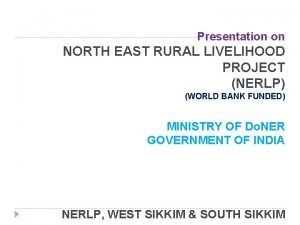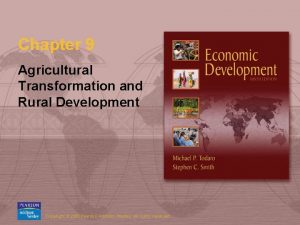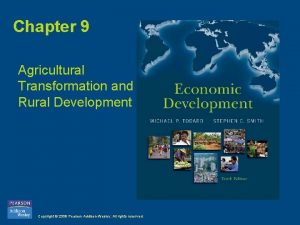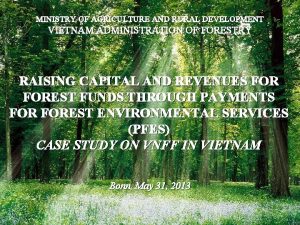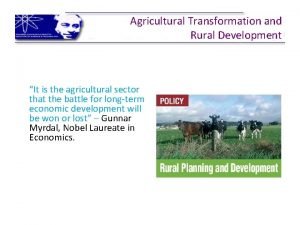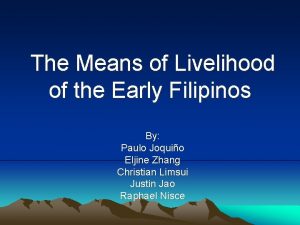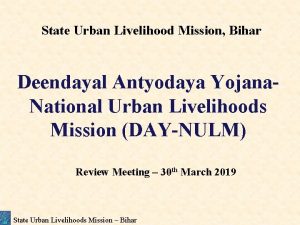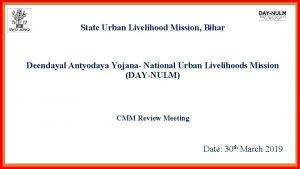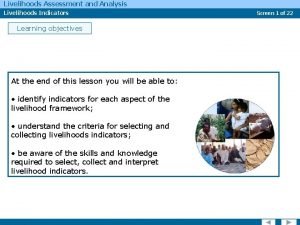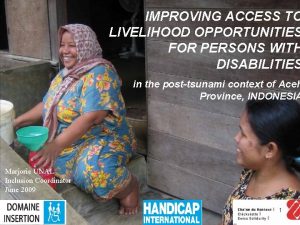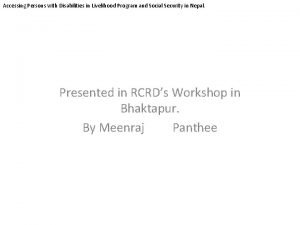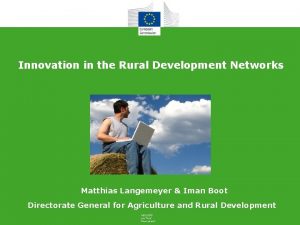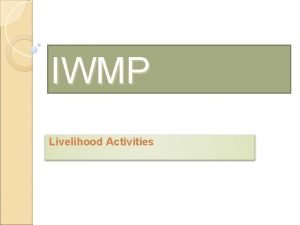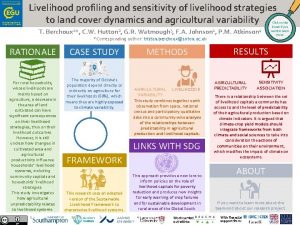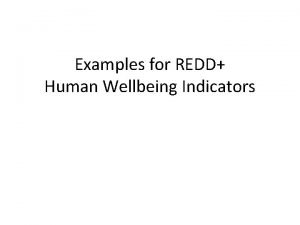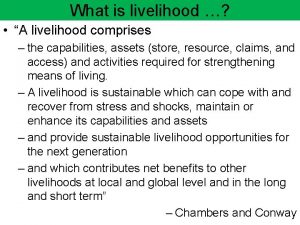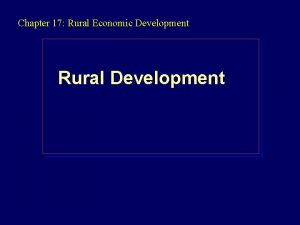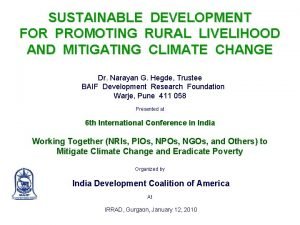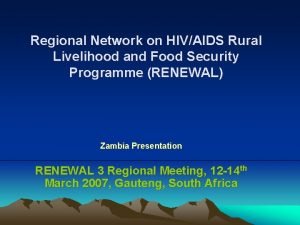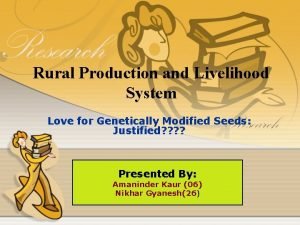LECTURE 4 LIVELIHOOD AND RURAL DEVELOPMENT 10 th














- Slides: 14

LECTURE 4: LIVELIHOOD AND RURAL DEVELOPMENT 10 th May 2011

LECTURE OUTLINES • • • Concepts and definition Dimensions of vulnerable livelihoods Sustainable livelihoods; poverty and vulnerability Livelihood strategies adaptation Income diversification is an important livelihood strategy for rural households • Poverty and rural livelihoods: the locational dimension • Utilizing the Sustainable Livelihood Framework for livelihood analysis

CONCEPTS AND DEFINITION Livelihoods definition · The dictionary definition of livelihood is a ‘means to living’ · A livelihoods comprises the assets (Natural, Physical, Human, Financial and Social Capital), the activities and the access to these (mediated by institutions and social relations) that together determine the living gained by the individual or household (Chambers and Conway, 1992). Sustainable livelihood · A livelihood is sustainable when it can cope with and recover from stresses and shocks, maintain or enhance its capabilities and assets, while not undermining the natural resource base. Rural livelihood diversification · Rural livelihood diversification is defined as the process by which rural households construct an increasingly diverse portfolio of activities and assets in order to improve their standard of living

Dimensions of Vulnerable Livelihoods • Vulnerability: the probability that livelihood stress will occur/degree of risk and ability to cope with it. • Vulnerable to external events (shocks and stresses) and internal (household) constraints. • Vulnerability depends on the ability of the livelihood system to absorb/use/exploit change (system, resilience’) and the degree to which a system changes (system ‘sensitivity’)

Food First vs Sustainable Livelihoods Food First Objective -Access to food Vulnerability - Lack or want of food Coping strategies – to maximise immediate consumption Sustainable Livelihoods Objective - Secure and sustainable living Vulnerability- Livelihood system not resilient & sensitive to risks & shocks Coping strategies – to preserve and build livelihoods

LIVELIHOOD STRATEGIES A range of activities: • Savings and borrowings • Accumulation • Changes in consumption patterns • Labour and asset pooling • Technological adaptation • Social networking • Labour market involvement (in which men and women engage to generate food, income and well-being). It draws on: A mix of resources: • Physical, human and collective assets, and • Opportunities - kinship/social networks

LIVELIHOOD STRATEGIES ADAPTATION Changes in • Circumstances • Season • Locale • Climate Changes in • Life cycle • Household structure In response to the above, they move between the stages of survival, stability and growth (Grown and Sebstad, 1989).

Income Diversification is an Important Strategy for Rural Households Diversity and diversification • Diversity refers to the existence, at a point in time, of many different income sources while diversification is an ongoing social and economic process, reflecting factors of both pressure and opportunity that cause families to adopt diverse livelihood strategies. • Different meanings of diversification: survival, income smoothing, risk reduction, accumulation. • Agriculture an important income source but rarely do rural households rely on one ‘occupation’. • Non-farm income sources are over 50% in Asia and 30 -50% in SSA (Depeasantisation? ). • Livelihood activities demonstrate that rural and urban links are strong. • With process of globalization, formal-informal divide becoming weaker.

A DIVERSIFIED RURAL LIVELIHOOD

Livelihood Diversification

POVERTY AND RURAL LIVELIHOODS: THE LOCATIONAL DIMENSION Rural Poverty: • Income poverty; • Infrastructure poverty - disadvantaged in terms of facilities (schools/ education), and outcomes Why are rural areas the sites of massive poverty? • Rural areas ignored by academics, politicians and practitioners • Development focus on ‘high potential’ rather than complex, isolated and risk prone rural areas (see Development Policy Review, 2001, 19(4)) • Rural potential criteria focus on agriculture – non recognition of other assets.

THE THREE RURAL WORLDS Source: WDR 2008

Sustainable Livelihood Framework for livelihood analysis

 North east rural livelihood project
North east rural livelihood project 01:640:244 lecture notes - lecture 15: plat, idah, farad
01:640:244 lecture notes - lecture 15: plat, idah, farad Chapter 9 agricultural transformation and rural development
Chapter 9 agricultural transformation and rural development Chapter 9 agricultural transformation and rural development
Chapter 9 agricultural transformation and rural development Ministry of agriculture and rural development cameroon
Ministry of agriculture and rural development cameroon Ecotourim
Ecotourim Agricultural transformation and rural development
Agricultural transformation and rural development Livelihood of early filipinos
Livelihood of early filipinos State urban livelihood mission
State urban livelihood mission Bihar sulm
Bihar sulm Nrlm mis.in
Nrlm mis.in Livelihood outcome indicators
Livelihood outcome indicators Livelihood opportunities for persons with disabilities
Livelihood opportunities for persons with disabilities Livelihood programs for persons with disabilities
Livelihood programs for persons with disabilities Matthias langemeyer
Matthias langemeyer
